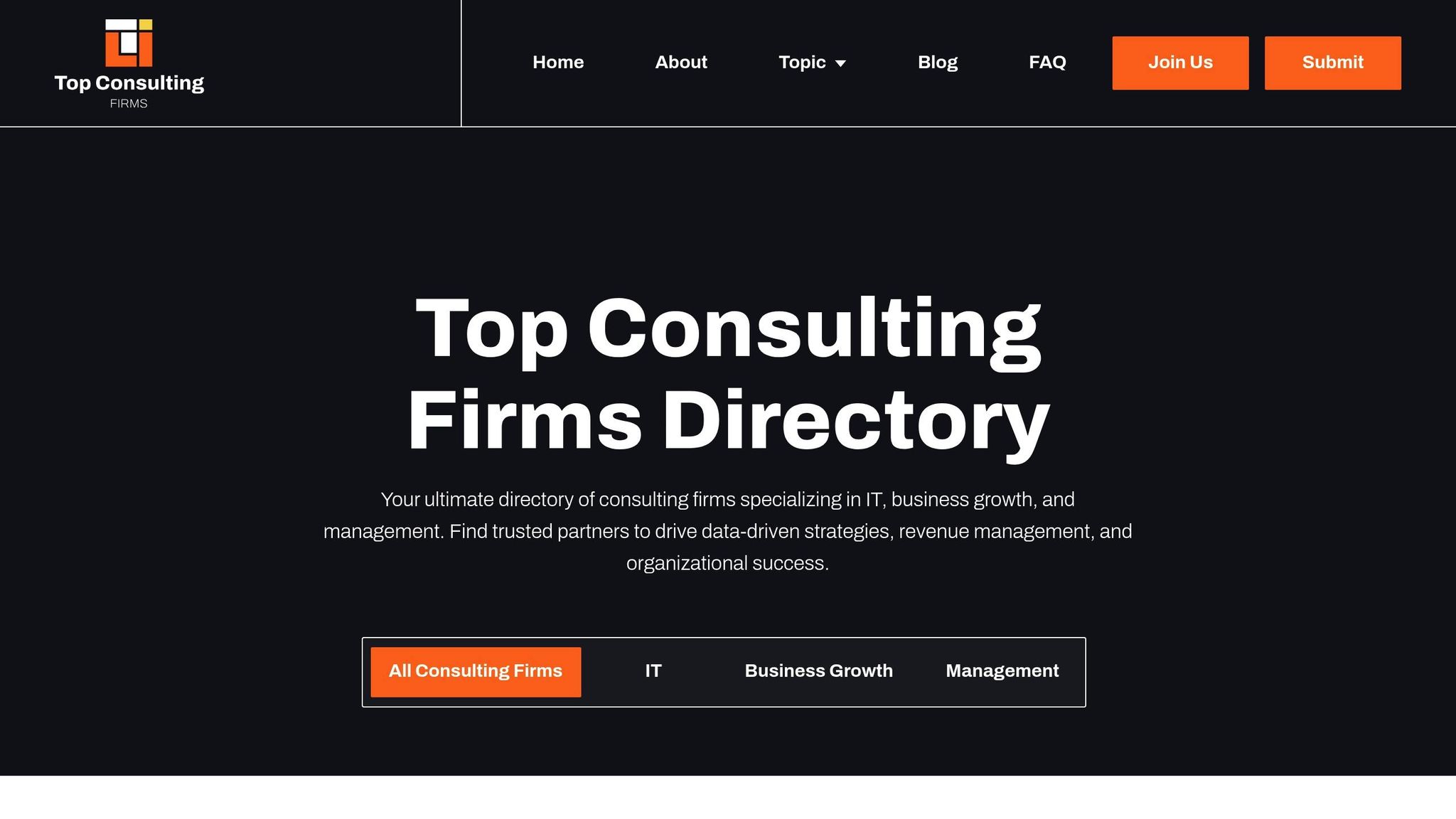Struggling with digital transformation? Here's the key: Core competency frameworks help organizations identify and develop the skills needed to succeed in a tech-driven world. With 87.5% of enterprises failing to meet transformation goals and 90% of IT hiring managers struggling to find talent, these frameworks provide a structured way to close skill gaps and align digital strategies with business goals.
Why Core Competency Frameworks Matter:
- Skill Gaps: U.S. ranks 29th in digital proficiency; 70% of jobs now require mid- to high-level digital skills.
- Success Rates: Only 35% of digital transformation efforts succeed.
- Key Competencies: Focus areas include data literacy, collaboration, content creation, cybersecurity, and problem-solving.
Popular Frameworks:
- DigComp Framework: Covers 5 key areas with 250+ skill examples.
- Amrop Digital Competency Model: Emphasizes leadership and strategy.
- Other options: SHL, European e-Competence, DDI, Lominger.
How to Build a Framework:
- Define clear objectives.
- Analyze job roles and responsibilities.
- Develop measurable competency levels.
- Align with business goals and update regularly.
Pro Tip: Simplify frameworks and involve employees early to reduce resistance and ensure success. With the right approach, frameworks can boost employee performance by 65% and help organizations achieve their transformation goals.
Reinforcing AI and Digital Transformation Competencies in the Public Sector - Dr. Marielza Olivera
Key Frameworks for Digital Competencies
In the push for digital transformation, U.S. organizations often rely on established frameworks to develop the skills needed for success. These frameworks provide structured approaches to mastering digital competencies.
Main Framework Options
One widely recognized framework is the DigComp framework, created by the European Commission. It outlines digital competence across five key areas and includes over 250 examples of skills in its latest version.
The Amrop Digital Competency Model focuses on digital leadership, emphasizing strategy, organization, and areas like digital DNA, cloud concepts, data-driven decision-making, IT architecture, security, and vendor management. An Amrop study uncovered a significant disconnect at the board level: while 69% of digital leaders report that their boards prioritize digitization, only 28% believe their boards fully understand its scope and meaning.
Other notable frameworks include:
- SHL Universal Competency Framework: A three-tier structure for assessing skills.
- European e-Competence Framework: Defines 41 IT-specific competencies.
- DDI Competency Framework: Focuses on five business strategy elements.
- Lominger Competency Model: Features 67 leadership competencies.
These frameworks typically group digital skills into core areas vital for transformation.
5 Core Areas of Digital Competence
The DigComp framework identifies five foundational areas of digital competence, which are essential for driving effective digital transformation.
- Information and Data Literacy: Involves searching, evaluating, and managing digital information. These skills are crucial for informed decision-making and operational efficiency.
- Communication and Collaboration: Focuses on digital interaction and teamwork. For example, DigComp 2.2 highlights how tools like video conferencing and project management platforms are vital for remote and hybrid work.
- Digital Content Creation: Covers skills for producing and sharing digital materials. This ranges from basic document creation to advanced tasks like multimedia production and web development.
- Safety: Emphasizes cybersecurity, privacy, and risk management. With growing cyber threats, this area includes understanding phishing, password management, and data protection.
- Problem Solving: Combines technical know-how with creative and analytical thinking. This area is about using digital tools to identify challenges, evaluate solutions, and implement improvements.
Factors for U.S. Organizations
Adapting these frameworks for U.S. organizations requires addressing specific cultural, technological, and financial factors.
- Cultural and Social Factors: Workplace culture and generational differences in digital familiarity affect how competency programs are designed. Transparency and inclusivity are key to success.
- Technology and Security Considerations: The fast-paced U.S. tech landscape demands a focus on data security, privacy, and platform interoperability. Frameworks must remain flexible to keep up with rapid innovation.
- Management and Financial Factors: Budget constraints and bureaucratic hurdles can slow digital initiatives. Leadership styles, financial incentives, and adaptable work policies play a crucial role in effective framework implementation.
A practical example of framework adaptation comes from the City of Seattle, which in 2024 used a community survey to organize digital skills into four categories: Basic skills, Setup skills, Security skills, and Collaboration skills. This tailored approach demonstrates how organizations can modify frameworks to suit their unique needs.
David Keyes, Advisor at NDIA, notes:
Mapping your training to these recognized frames and skills will help you share with others, lend credibility to the design of your programs, and provide some benchmarks for you to recognize the success of your students in completing levels of training.
U.S. organizations that succeed in digital transformation often take a targeted approach. Rather than applying a generic model, they focus on specific skill sets that align with their business goals, building complementary capabilities to maximize impact. This method avoids the trap of overly broad programs that fail to deliver tangible results.
Building and Using Competency Frameworks
Creating a competency framework for digital transformation requires a structured process that bridges individual skills with organizational objectives. This involves careful planning, engaging key stakeholders, and regular updates to ensure it delivers measurable outcomes.
Steps to Build a Competency Framework
Building an effective competency framework involves several essential steps:
- Define objectives: Identify both short- and long-term goals, such as improving employee assessments, crafting precise job descriptions, and supporting digital transformation efforts.
- Gather information: Analyze job roles and responsibilities while collaborating with stakeholders to ensure the framework addresses practical needs.
- Construct the framework: Develop it around five key components: Core values, Core competencies, Functional competencies, Meta competencies, and Leadership competencies.
- Establish measurable levels: Define competency levels and validate them through expert reviews, pilot programs, and performance data analysis to ensure they predict success in digital transformation roles .
Implementation Best Practices
After creating the framework, applying these best practices ensures it delivers on its potential:
- Clear Communication: Make sure employees understand how the framework supports their professional growth and ties into organizational success.
- Integrate with HR Systems: Embed the framework into recruitment, performance management, and development programs to make it a practical, everyday tool rather than a static document .
- Manager Training: Train managers to assess competencies, provide constructive feedback, and identify development opportunities. Using real-world scenarios and role-playing can boost their confidence in applying the framework effectively.
- Digital Accessibility: Ensure employees can easily access the framework whenever they need it.
- Regular Updates: Schedule periodic reviews to refine the framework based on changing business needs and strategic priorities.
Research underscores the value of well-designed competency frameworks. Organizations with clearly defined competencies are 50% more likely to achieve their strategic goals. Companies prioritizing competency development are 2.5 times more likely to outperform their peers in revenue growth, and 65% of organizations using competency frameworks report improved employee performance and engagement.
"Competency frameworks provide the infrastructure that connects individual capability to organizational performance. When designed correctly, they transform abstract strategic goals into concrete behaviors that can be developed, measured, and rewarded."
– Dr. Ruth Wageman, Organizational Behavior Expert at Harvard University
"The biggest mistake organizations make with competency frameworks is treating them as HR documents rather than business tools. Successful frameworks translate strategic goals into everyday behaviors that managers can observe, develop, and reward."
– Josh Bersin, Global Industry Analyst and Founder of the Josh Bersin Academy
To ensure long-term success, organizations should treat competency frameworks as dynamic tools that are integral to business performance. By keeping these frameworks flexible, businesses can adapt to new technologies and evolving models, ensuring they remain relevant and effective.
sbb-itb-97f6a47
Implementation Challenges and Success Factors
Even when organizations design competency frameworks with care, putting them into practice often comes with hurdles. Tackling these challenges head-on is essential for achieving meaningful results in digital transformation efforts.
Common Implementation Problems
One of the biggest roadblocks is employee resistance. According to a McKinsey study, nearly 70% of change initiatives fall short, largely due to employees resisting change or feeling disengaged. This resistance often arises from fears about job security, uncertainty about what the changes mean, or skepticism about the framework’s benefits. Many employees perceive competency assessments as punitive rather than developmental.
Another pressing issue is skills gaps. The World Economic Forum estimates that 60% of workers will need to be retrained or upskilled within the next five years, yet only half currently have access to the training they need. Without sufficient resources to close these gaps, organizations may find themselves stuck, unable to develop the digital skills required for success.
Resource constraints also pose a challenge. Limited budgets can make it difficult to invest in the tools and training programs necessary for implementation. Additionally, outdated legacy systems often require expensive updates, further straining resources.
The complexity of frameworks can be another stumbling block. When competency frameworks are too generic, they often lead to unclear goals and make it harder to align learning initiatives with measurable outcomes. This lack of clarity leaves managers unsure about how to provide feedback and employees uncertain about their growth paths.
Finally, organizational silos make collaboration across departments difficult. Without consistent application, the framework’s impact can be diluted, reducing its overall effectiveness.
Solutions for Common Problems
To address resistance, organizations need a robust change management strategy. Communication is key - leaders should explain the reasons for change and its benefits, using multiple platforms to engage employees. Involving employees in planning and implementation fosters a sense of ownership, which can significantly reduce pushback.
Bridging skills gaps requires targeted investments in training. Offering personalized development opportunities, such as mentorship programs or access to external learning resources, can accelerate skill-building efforts.
Dealing with resource constraints calls for careful planning and a phased approach. By identifying high-impact areas and demonstrating value early on, organizations can build momentum before rolling out the framework on a larger scale. Detailed implementation plans that ensure compatibility with existing systems are also crucial.
Simplifying frameworks is another effective strategy. Focusing on specific, measurable competencies makes them easier to apply in real-world scenarios. Regular updates based on feedback and evolving business needs can keep the framework relevant and actionable.
Breaking down silos requires collaboration from the start. Clear governance structures and communication channels ensure that competency requirements are consistently interpreted and applied across departments.
Critical Success Factors
Overcoming these challenges lays the groundwork for success, but certain factors stand out as essential.
Leadership commitment is one of the most important. Research from Prosci highlights that active and visible sponsorship by leaders is the top driver of successful change initiatives. Leaders need to model the behaviors they expect and show genuine enthusiasm for the framework.
Strategic alignment is another key factor. When digital transformation initiatives align with broader business goals, it becomes easier to justify investments and maintain focus.
Continuous monitoring and adaptation are vital for long-term success. Regularly evaluating the framework’s effectiveness allows organizations to identify areas for improvement and adapt to emerging challenges.
Providing comprehensive training and support ensures employees feel confident in their roles. This not only helps them meet new competency requirements but also boosts overall engagement and performance.
The stakes for getting this right are high. Only about one-third of digital transformation projects are completed as planned, delivering the intended value to the business. Failure rates in digital transformation initiatives can reach 70% across industries, and in 2018, of the $1.3 trillion spent on digital transformation, an estimated $900 billion was wasted.
"Innovation is not just about spending money to buy new technologies. Innovation is really about how you drive new ways of thinking, which is how you're going to actually use these new technologies."
– Ryan Daly Gallardo, SVP, Consumer Products at Dow Jones
For competency frameworks to succeed, organizations must treat them as strategic tools rather than simple HR checklists. By addressing resistance, aligning efforts with business goals, and investing in proper change management, companies can significantly improve their chances of meeting their objectives. These success factors directly address the challenges outlined earlier, ensuring the framework delivers real business value.
Using the Top Consulting Firms Directory

Specialized consulting firms make implementing competency frameworks more efficient by offering expert guidance. The Top Consulting Firms Directory serves as a valuable resource for organizations seeking these services.
How the Directory Supports Digital Transformation
The digital transformation consulting market is expected to grow to nearly $11 billion by 2026, with an annual growth rate of 7.5%. McKinsey research reveals that 90% of companies are currently undergoing some form of digital transformation .
The directory helps meet this growing demand by connecting businesses with consulting firms specializing in IT, digital transformation, and organizational change. Instead of spending weeks researching potential partners, organizations can access a curated list of firms with established expertise in designing and implementing competency frameworks.
Through the directory, organizations can compare firms based on services, areas of expertise, and industry focus - whether they operate in niche sectors like healthcare or provide solutions across multiple industries. Businesses can also evaluate firms by reviewing their digital transformation methodologies, success metrics, and experience.
"It's «show me the money» time. A CEO agenda item is necessary for a digital transformation to succeed." - Rodney Zemmel, Senior Partner at McKinsey
This quote highlights the importance of selecting the right consulting partner. The directory simplifies this process by showcasing firms with transparent revenue models and the ability to align with a company’s culture. This alignment is crucial for fostering collaboration and ensuring the success of any organizational changes. The insights provided by the directory help businesses find tailored consulting services that address every stage of their transformation journey.
Consulting Services Offered
The firms listed in the Top Consulting Firms Directory provide a wide range of services, addressing both technical and strategic aspects of digital transformation. These services include:
- Technology & Infrastructure: Solutions like cloud services, data analytics, cybersecurity, API management, and DevOps to establish a solid technical foundation for competency frameworks.
- Strategy & Business Processes: Services such as technology assessments, strategy development, business process optimization, and change management to ensure frameworks align with broader business goals.
- Competency & Change Management: Employee-focused initiatives like skill gap analysis, training programs, and change management strategies that prioritize the human element of transformation.
- Industry Specialization: Expertise tailored to industries like healthcare, financial services, and manufacturing, ensuring compliance with specific regulations and standards.
As digital transformation spending is projected to hit $2.8 trillion by 2025, organizations require partners with a combination of technical and strategic capabilities. The directory helps identify firms that bring this diverse expertise to the table.
When choosing a consulting partner, businesses should assess factors such as industry knowledge, technical skills, revenue models, cultural compatibility, and a results-driven approach. The directory provides the tools to make informed decisions and drive successful transformation initiatives.
Conclusion
Core competency frameworks lay the groundwork for successful digital transformation, offering a clear strategy to tackle the complexities of technological change. Organizations that prioritize their core strengths during transformation efforts are far more likely to succeed, making these frameworks a necessity rather than a luxury.
These frameworks play a critical role by streamlining resource allocation, improving data-driven decision-making, and fostering alignment across teams. They also help identify potential risks early while keeping the focus firmly on the customer. As David Tang from Core Competence explains:
"Core competencies are vital for the success of legacy organizations in digital transformation, driving differentiation, innovation, and sustainable growth through strategic investment and adaptation".
With 70% of large-scale transformation efforts failing, expert guidance becomes indispensable. The Top Consulting Firms Directory addresses this by connecting businesses with consulting partners who specialize in both the technical and strategic aspects of implementing competency frameworks. This approach ensures organizations can maximize their digital investments. The statistics speak volumes: digitally mature companies are 26% more profitable.
The directory simplifies the process of finding the right consulting partner, focusing on firms with proven expertise in areas like digital transformation, change management, and industry-specific needs. Whether your organization requires support with technology infrastructure, business process optimization, or managing organizational change, the directory helps you find partners who align with your transformation goals and company culture. This expert guidance bridges the gap between strategic planning and effective execution.
Digital transformation isn't just about adopting new technologies - it’s about building a structured approach around core competencies. By combining strong frameworks with specialized consulting, organizations can turn the challenges of transformation into opportunities for growth and competitive advantage.
FAQs
What are the best ways to address employee resistance when introducing core competency frameworks for digital transformation?
To navigate employee resistance during digital transformation, it’s important to involve employees right from the start. By including them in planning and decision-making, you can create a sense of ownership and reduce potential backlash. Make sure communication is clear and consistent - explain why the change is happening, how it benefits the company, and what it means for employees on a personal level.
Another crucial step is offering training and support. Equip your team with the tools and knowledge they need to confidently adapt to new systems or processes. It’s also important to acknowledge emotional concerns, such as fear of the unknown or uncertainty about their roles, and address these with empathy to build trust. Lastly, present a strong, inspiring vision for the transformation that connects to the organization’s goals and motivates employees to embrace the journey ahead.
What key factors ensure a competency framework supports business goals during digital transformation?
To create a competency framework that truly supports business goals during digital transformation, the focus should be on aligning it closely with the organization's objectives. This means setting clear priorities and incorporating the skills and behaviors that will propel digital initiatives forward.
Some key aspects to consider are fostering strong leadership, encouraging flexibility, and building a culture of continuous learning. Highlighting skills like digital literacy, teamwork, and creative problem-solving ensures the framework stays relevant as strategies and market conditions shift. By concentrating on these areas, organizations can better navigate their transformation journey and position themselves for lasting success.
How do competency frameworks help organizations address skill gaps and enhance employee performance?
Competency frameworks serve as practical tools for pinpointing and addressing skill gaps within a company. By outlining the specific skills, behaviors, and knowledge needed for each role, they make it easier to design focused training programs and development plans that align with both employee growth and the organization's objectives.
These frameworks also support fair and unbiased skill assessments, ensuring evaluations are consistent and transparent. When it comes to digital transformation, they become even more essential by defining the key digital skills employees need to embrace new technologies and workflows. Aligning workforce abilities with strategic goals not only boosts individual performance but also strengthens the overall success of transformation efforts.


